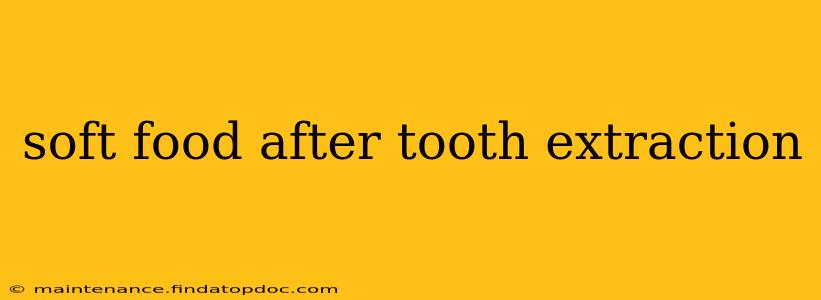Having a tooth extracted can be a bit of a rough experience. Beyond the immediate discomfort, the post-operative healing process requires careful attention to your diet. Eating the right foods – soft, easily digestible options – is crucial for a speedy recovery and minimizing the risk of complications. This comprehensive guide will explore the best soft foods to eat after tooth extraction, addressing common questions and concerns.
What are the best soft foods to eat after a tooth extraction?
The ideal soft food after a tooth extraction should be:
- Easy to chew: Avoid anything that requires significant jaw movement or pressure.
- Gentle on the extraction site: Foods should be smooth and non-irritating to prevent further injury.
- Nutrient-rich: Your body needs nutrients to heal effectively, so prioritize nutritious choices.
Here's a list of excellent options:
- Soups: Broths, pureed soups (like tomato or butternut squash), and cream-based soups are all great choices. Avoid soups with chunks or hard vegetables.
- Yogurt: Plain yogurt is a fantastic source of protein and probiotics, beneficial for gut health during recovery. You can add a touch of honey for sweetness.
- Applesauce: Smooth and easy to swallow, applesauce offers essential vitamins and fiber.
- Mashed potatoes: A classic comfort food, mashed potatoes are easily digestible and packed with carbohydrates for energy.
- Scrambled eggs: Soft-cooked eggs provide protein and essential nutrients, but make sure they're well-cooked and not chunky.
- Oatmeal: A warm and comforting breakfast option, oatmeal is easy to swallow and offers fiber.
- Smoothies: Blend fruits, vegetables, and yogurt for a nutrient-rich and delicious meal replacement. Avoid adding ice, which can be too hard.
- Pudding: A sweet treat that's gentle on the gums, pudding can be a good option for dessert. Choose sugar-free options where possible.
- Bananas: Ripe bananas are soft and easy to mash, providing potassium and other essential nutrients.
- Avocado: Avocados are creamy and packed with healthy fats, ideal for promoting healing.
What foods should I avoid after a tooth extraction?
It's equally important to know what to avoid. These foods can disrupt the healing process and potentially cause complications:
- Anything crunchy or hard: Nuts, chips, crackers, and hard candies can dislodge the blood clot, leading to dry socket.
- Foods requiring strong chewing: Steaks, raw vegetables, and tough meats should be avoided.
- Extremely hot or cold foods: These can cause pain and discomfort at the extraction site.
- Spicy foods: Spicy foods can irritate the sensitive area.
- Straws: Sucking through a straw creates suction that can dislodge the blood clot.
- Alcohol and smoking: These can impede healing and increase the risk of infection.
How long should I eat soft foods after a tooth extraction?
The length of time you need to stick to a soft food diet varies depending on the complexity of the extraction and your individual healing process. Generally, you should plan on eating soft foods for at least a week. Your dentist or oral surgeon will provide specific instructions and guidance based on your case. Listen to your body; if you experience any pain or discomfort, continue with the soft foods until the pain subsides.
Can I eat solid foods after a week?
After a week, you can gradually reintroduce solid foods into your diet. Start with softer textures and gradually increase the hardness as your mouth heals. Pay attention to any discomfort and return to soft foods if you experience pain.
What if I experience dry socket?
Dry socket, also known as alveolar osteitis, is a painful condition that can occur when the blood clot at the extraction site is dislodged. Symptoms include intense pain, a bad odor, and a visible empty socket. If you suspect you have dry socket, contact your dentist or oral surgeon immediately. They can provide treatment to alleviate the pain and promote healing.
What if I'm struggling to find enough variety in my soft food diet?
It's understandable to feel limited by the soft food diet. To increase variety, experiment with different combinations of soft foods. For example, you could blend fruits and yogurt into a smoothie, or puree vegetables into a soup. Consult with a registered dietitian or your dentist for additional suggestions to ensure you're getting all the necessary nutrients.
Remember, this information is for general knowledge and shouldn't replace advice from your dentist or oral surgeon. They can provide personalized recommendations based on your specific situation and medical history. Prioritizing proper post-extraction care will contribute significantly to a comfortable and efficient healing process.
